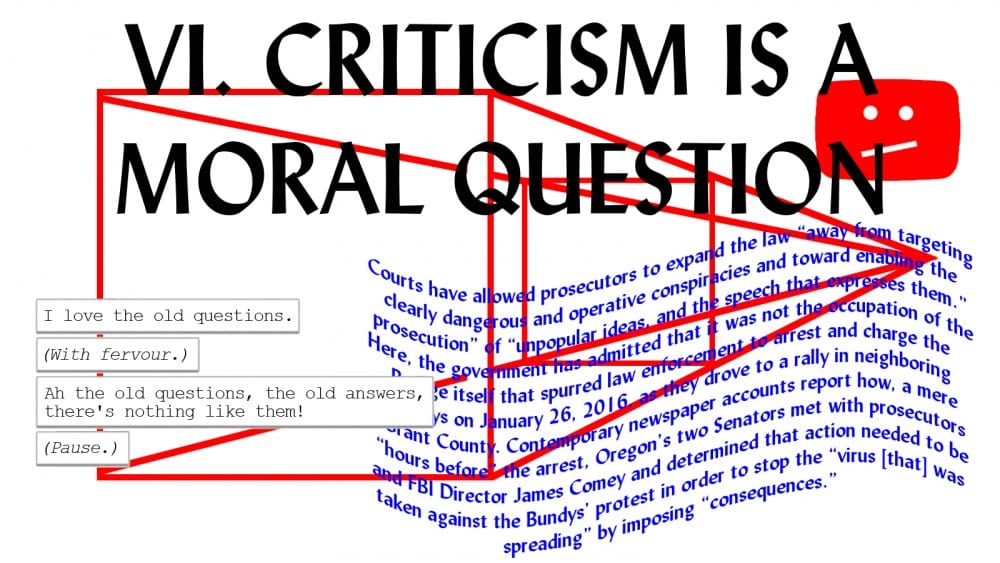The following essay by James McAnally is part of “Beyond Survival: Public Support for the Arts and Humanities,” a call for reflections on and provocation about the precarious state of arts funding after decades of neoliberal economics and the long culture wars.
Let’s start with a provocation, although one that seems to be a given at this stage: The right has been more strategic than the left for at least three decades, matching its strategy with structure, its funding with a vision for the future. Over the course of the interminable cultural wars, the right has moved from a reactionary position to one of consistently outflanking its opposition, whom have mostly won the day in terms of the work hung on the walls of our galleries while all but giving the place away in relation to policy, budget, and boardroom discussions. From the 1990s on, each outcry over artistic content from the right was accompanied by a generalized dismantling of public forms of support—a move from speech to structure, in other words. This large-scale privatization never had really anything to do with morality, which was always a populist pretext to justify its actions, yet those of us in the drought at the end of the trickle down have internalized this austerity, and made do with what remains. In essence, we have been losing the culture wars while seeming to win all the battles. Strategy is a military term, after all, and one side is more comfortable in war than the other.
Take the DeVos family’s multifaceted strategies as a test case. Few have a comparable track record for dismantling public infrastructure in favor of neoliberal models, whether in education, the military, or the arts. The pyramid scheme–funded family of famous cultural philanthropists is behind the pseudo-democratic ArtPrize in Grand Rapids; serves on boards, like that of the Whitney Museum of American Art; and, importantly, funds the DeVos Arts Management Institute, one of the primary “think tanks” responsible for exporting fundraising, policy, and management strategies throughout the cultural sector. In other words, the DeVoses shape policy not only discretely, but directly; not just locally, but nationally; and not just regarding content, but structural concerns.
This is a radical position for remaking our cultural landscape along quintessentially neoliberal lines. It is clear, strategic, complete. Nothing approaching this ambition is currently on offer from the left, which has been content to fend off complete closure of our inherited national endowment while it continually adjusts to new dismal normals rather than articulating an alternate vision of art, its publics, and its structures of support. The besieged NEA is barely envisioned as a site of widespread advocacy worthy of our energy; it is just another public good we hope is not completely siphoned off before we get organized.

Opposition, it seems, is twofold and requires both bold form and strategic experimentation. A first step is to sustain and expand spaces committed to reconstructing a vision of the commons. This is the work of the independent, the alternative, the artist-run, the bottom-up, the self-organized and prefigurative institution of any scale. Through lived practice, we may imagine new kinds of frameworks needed, new modes of mutuality and equitable exchange, as well as a continuance of those things that never needed changing to begin with. If our social vision, and therefore our institutional vision, is truly what we think the world needs, then we need to build, sustain, and extend these spaces, at whatever scale we can, inviting intersectional publics to form and reform them.
The second step is to envision, advocate for, and get strategic about robust funding structures in line with (and beyond) the NEA’s original commission. If we cannot imagine an actionable and comprehensive national funding strategy, then we will almost certainly not have one. To adopt a paraphrased activist adage: If we are not organizing, we are being organized. This, too, is a question of imaginaries: can we imagine the texture, structure, and policies of a funding body that matches our coming community? Can we describe what this commons looks like, feels like, how it operates, how it connects us to one another, how it makes space for dissent, and takes care of those groups our current structures ignore, or harm?
This is an urgent appeal to reinstitute art as a shared cultural good and articulate how the NEA and others can be the guarantors of a cultural commons that reaches rural and urban, grassroots and institutional, intersectional and equitable, experimental and a-formal. We cannot delay any longer in reasserting art as both a voice of its time and a vision into a more equitable, interconnected, and imaginative future. All art is political, sure, but it may also be where politics can emerge. Not just in content, but in structure.
Based in St. Louis, Missouri, James McAnally is the co-founder of Temporary Art Review and the founder and co-director of The Luminary.
The next response in the Beyond Neoliberalism chapter is “The Public More Private, the Private More Public” by Cher Krause Knight.
